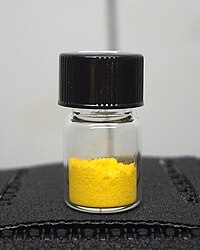Lead(II) iodide
 |
|
 |
|
| Names | |
|---|---|
| Other names
Plumbous iodide
|
|
| Identifiers | |
|
10101-63-0 |
|
| 3D model (Jmol) | Interactive image |
| ChemSpider |
23305 |
| ECHA InfoCard | 100.030.220 |
| PubChem | 167719 |
| UNII |
OTL90F2GLT |
|
|
|
|
| Properties | |
| PbI 2 |
|
| Molar mass | 461.01 g/mol |
| Appearance | bright yellow powder |
| Odor | odorless |
| Density | 6.16 g/cm3 |
| Melting point | 402 °C (756 °F; 675 K) |
| Boiling point | 953 °C (1,747 °F; 1,226 K) |
|
|
|
Solubility product (Ksp)
|
4.41 x 10−9 (20 °C) |
| Solubility |
|
| Band gap | 2.3 eV |
| −126.5·10−6 cm3/mol | |
| Structure | |
| Rhombohedral, hexagonal hP3 | |
| P-3m1, No. 164 | |
| octahedral | |
| Hazards | |
|
EU classification (DSD)
|
Repr. Cat. 1/3 Harmful (Xn) Dangerous for the environment (N) |
| R-phrases | R61, R20/22, R33, R62, R50/53 |
| S-phrases | S53, S45, S60, S61 |
| NFPA 704 | |
| Flash point | Non-flammable |
| Related compounds | |
|
Other anions
|
|
|
Other cations
|
Tin(II) iodide |
|
Related compounds
|
|
|
Except where otherwise noted, data are given for materials in their standard state (at 25 °C [77 °F], 100 kPa).
|
|
|
|
|
| Infobox references | |
Lead(II) iodide or lead iodide is a salt (chemistry) with the formula PbI
2. At room temperature, it is a bright yellow odorless crystalline solid, that becomes orange and red when heated. It was formerly called plumbous iodide.
The compound currently has a few specialized applications, such as the manufacture solar cells and X-ray and gamma-ray detectors. Its prepraration is a popular demonstration in basic chemistry education, to teach topics such as double displacement reactions and stoichometry. It is decomposed by light at moderately high temperatures and this effect has been used in a patented photographic process.
Lead iodide was formerly employed as a yellow pigment in some paints, with the name iodide yellow. However, that use has been largely discontinued due to its toxicity and poor stability.
PbI
2 is commonly synthesized via a double displacement reaction between potassium iodide KI and lead(II) nitrate Pb(NO
3)2 in water solution:
While the potassium nitrate KNO
3 is soluble, the lead iodide PbI
2 is nearly insoluble at room temperature, and thus precipitates out.
...
Wikipedia

